When I was 7 years old, I remember watching two neighbors playing Dark Tower. Shane and David were a couple of years older than me and were sprawled on the red shag carpet pressing the buttons, listening to the beeps, and moving the pieces around on the board. I desperately wanted to play, too, but was told, "No, you're too young."
Over the years, Dark Tower became cult classic and increasingly hard to find. Electronic toys, especially ones from the 80s, are notoriously flaky, so many towers stopped working. Thus, a group of fans, who also happened to be game designers, artists and engineers, decided to reimplement Dark Tower using modern game play mechanics and, to preserve the essence of the original, modern technology.
Forty years after being too young to play, I own both versions of the Dark Tower.
In a recent poll on BGG some 50% of responders stated nostalgia wasn't one of the reasons they backed (or bought) Return to Dark Tower. What that tells me there are a lot of people out there who have never played the original.
To those who want a trip down memory lane or to those who've never played the cult classic want to know what the hype is about, keep reading. How are they different? How to they compare? Will people be paying $500 for a copy of Return to Dark Tower in another forty years? Let's take a look.
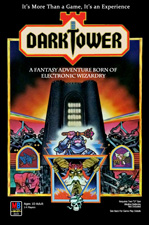 |
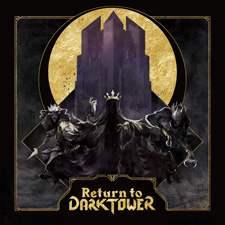 |
|
Dark Tower (1981) |
Return to Dark Tower (2022) |
| Designer(s) |
Roger Burten, Alan Coleman, Vincent A. A. J. Erato |
Isaac Childres, Noah Cohen, Rob Daviau, Justin D. Jacobson, Brian Neff |
| Publisher |
Milton Bradley (now part of Hasbro) |
Restoration Games |
| History |
This game was by far the most technically advanced game of its time. Handheld electronic games were big, but video games still didn't exist (the Atari 2600 was still a year away from being released). The Dark Tower was a powerful blend of the handheld electronic game craze and a beautiful, stylistic board game. |
The designers' goal was to bring that same sense of awe and wonder they had with the original game as well as push the boundaries of what a modern board game can actually be. After 3 years of game design, engineering, and artistry the KickStarter launched in February of 2020 as COVID was exploding across the globe. A month later, it successfully funded over $4M. Two years later, in March of 2022, fulfillment began. |
| BGG Page |
Dark Tower @ BGG |
Return to Dark Tower @ BGG |
| Weight |
1.81 (out of 5) - Medium-Light |
2.65 (out of 5) - Medium |
| Time to Play |
~90 minutes |
100-120 minutes |
| Game Play |
Players start in their home kingdom in their Citadel and must journey clockwise around the entire board looking for 3 keys (one each in the other kingdoms) which will grant them the ability to siege the Dark Tower. Moving one space per turn, a Hero enters a new territory and deals with whatever they encounter. This could be battling brigands (the only type of foe along side the dragon), finding treasure, getting lost (losing a turn), exploring the building, buying resources, getting the plague, finding a key, or other scenarios. The Tower's electronics managed all of this for you. Once a Hero finds all 3 keys, they return to their home kingdom to solve The Riddle of the tower and, finally, battle the Dark Tower. The first player to successfully do all of this wins the game. |
The basic game is a cooperative game, however there is a competitive variant described in the rules. In coop mode, the players work together to achieve a Main Goal which is based on the companion chosen during setup. While they do this, they will complete smaller goals, collect items (potions, spirit, warriors, etc.) and battle foes. Once the Main Goal is achieved, the game spawns the Adversary (i.e. the Big Boss) who must be defeated to win the game.
The competitive mode is a closer approximation of the original's game play. Players start in their home kingdom and are given 3 "Heroic Tests" to complete which are different for each player. The Heroes travel over the board (in any direction) to complete them. Once completed, they must travel to the Tower, enter it (Quest action) and search its dungeon to find the Relic. This searching is done entirely on the app. The first player to find the Relic wins.
|
| Mechanics |
Area Movement, Push Your Luck, Race, Resource Management (sort of) |
Area Movement, Cooperative Game, Events, Push Your Luck, Random Production, Sudden Death Ending, Trading, Variable Player Powers, Variable Set-up |
| Randomness |
In true RPG fashion, there is some "dice rolling", but the Tower does the rolling for you. When you move into a new territory, another algorithm determines what you discover there (brigands, a key, nothing...). Also, when you battle, the Tower runs an algorithm that applies damage to each side. So there is a fair amount of randomness that is managed by the Tower. |
There is a significant amount of randomness in this game. Not only are are several decks of cards you are drawing from, but the app manages a lot, too. Foes spawn in a some-what random pattern, battling them requires virtual cards to be drawn, and dungeon layouts seem to be randomly generated when you're searching them (thus the same dungeon can't be searched the same way twice). And, of course, there is the Haggle Die. |
| BGG Rating |
5.972 - 2,719th overall |
5.958 - 1,287th overall * |
| Cost |
When Dark Tower came out in 1981, it was an expensive game. When other board games of the time cost $10 or so, Dark Tower cost a hefty $50 or $60. Today, finding a complete copy with a functioning tower commands $450 or more on eBay (see the links below). |
It, too, is a pricey game. Expect to spend well over $150 (see the links below). |
| Expansions |
There is no expansion for Dark Tower, but there are several rules variants out there. |
The Alliances expansion was released at the same time as the base game and offers new rules and components to add further depth and variety to the base game. |
The Boxes
In 1981, the board game section of the KB Toys was filled with long, flat boxes that were about an inch deep (think Monopoly). Then there was the Dark Tower box that was a whooping 4-inches deep and literally towered over the others! It was a statement! It made everyone wonder, "What is inside that box!" Forty-some years later, the D&D-esque art is dated, but the box still commands attention.
Return to Dark Tower, on the other hand, is packaged in a sleek box that's standard sized, but also about 4-inches deep. The cover art is sleek, modern and powerful (as is all of the art inside the box), but it just doesn't command attention. It will sit on the shelves of FLGSs amongst a plethora of modern games and, unfortunately, there's just no way it will stand out like the original box did next to boxes of Candy Land, Monopoly, and Scrabble.
More importantly, what are the differences inside the boxes? There are a lot of similarities between the two games in terms of mechanics, components, and theming, but they are definitely different games.
The Setup
The original game had little more than its 16 buildings and the player-resource tracking boards (called score charts) to set up and it took only a couple of minutes to be ready to play. The new game has a lot more things to setup, including the app, so it takes good 10 minutes. This also goes for putting the game away. Return to Dark Tower has fancy custom inserts, but it takes time to get everything back in its place when putting the game away.
Components
- The Dark Towers
- The two towers are significantly different. Both Towers have lights and 8-bit sounds, but that where their similarities end.
- The original tower contained a 12-button keypad interface and three "windows" to display the information the Tower needs you to know. Behind each of the 3 windows was a spinning ring of translucent pictures and a lightbulb that would illuminate it. During a turn, a player would turn the Tower towards them and interact with it as secretly as possible (though the sounds gave away a lot of what it was telling the player). They would press the appropriate key(s) for their action and the Tower would whirr as it spun the pictures around. Once the whirring stopped, the tower would illuminate one of the pictures. There was also a 2-digit display on top to give you any numbers you needed to know such as how many warriors you still had.
- The new Tower is also a technical marvel. First, it is Bluetooth enabled and is controlled by the Return to Dark Tower companion app on your phone or tablet. The new Tower also has 3 spinning levels, but instead of displaying pictures, they distribute the skulls through the 12 doors (called "seals") and out onto the board. As players drop skulls into it (more on this later) and the Tower/app decides what to do with them and will either spit them out immediately or hold on to them for later.
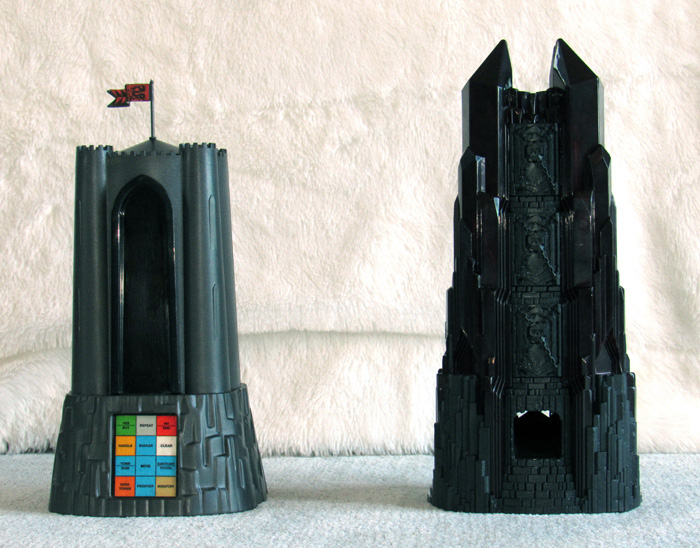 |
- The Game Boards
- Aside from the ominous Dark Tower in the center, both game boards are very similar. Both are circular with 4 quadrants called kingdoms. The new board definitely has a darker, more sinister design that is a stark contrast to the lighter, 80's D&D style of the original. The territory layouts within each kingdom are slightly different. Also, the original kingdoms are divided by Frontiers were the new ones are divided by Rivers.
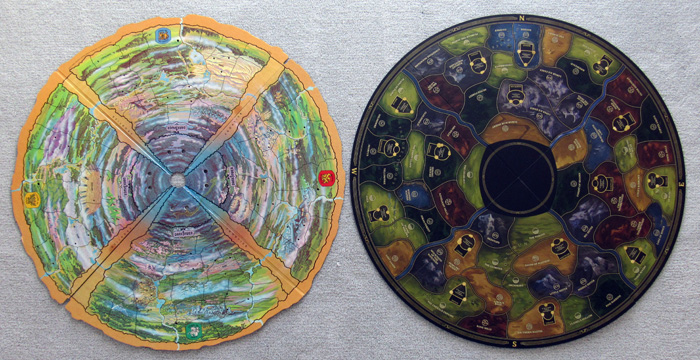 |
- The Buildings
- Each game has 4 different types of buildings, though only some overlap.
- Citadels - While both games have Citadels, their functions are very different. First, in the original game they were printed on the board (rather than being physical pieces) and you couldn't enter a Citadel space that wasn't your own. Second, you only entered your own Citadel once you had all 3 keys and were ready to assault the Tower. In Return to Dark Tower, Citadels were just another building you could visit regardless of what kingdom it is in and there you could obtain a potion or a virtue.
- Bazaars - While the rules are slightly different, both games have Bazaars where you get resources and haggle with the Shop Owner (more on this below). At a Dark Tower Bazaar, for gold you can buy warriors, a Beast, a Scout, or other items. At a Return to Dark Tower Bazaar, you can get a gear or a treasure.
- Sanctuaries - Both games also have Sanctuaries. At a Dark Tower Sanctuary, you can get warriors, gold, or food if you were low. At a Return to Dark Tower Sanctuary, you can get sprit or remove corruption.
- Ruins and Tombs - These only existed in Dark Tower and had to be explored by the heroes. In them players would find nothing or need to battle brigands. If they did and won, they would be awarded an item which could be a key that they need. This type of action (exploring a tomb or ruin) is reimplemented as the Explore a Dungeon action in the new game, though it's greatly expanded action.
- Villages - Villages are new to Return to Dark Tower and are where you obtain (recruit) warriors.
 |
- Resources
- The original game didn't have resources components like today's games do. Instead players tracked their warriors, gold, and food with pegs on a numbered score chart. Whether or not a player had a Scout, a Beast, and the DragonSword was also tracked with pegs on the same score chart.
- The new game comes with tokens for warriors and spirit, the two main resources. Companions (upgraded versions of the Scout) are cards that are taken by the player who obtains them.
- Interestingly, the original Dark Tower tracked much of the game-state where the new one (well, the app, at least) decidedly doesn't. As such, the original tower knew how much of each resource each player had. The players just kept their cardboard score chart up to date with the numbers the Tower showed them. The new tower / app performs no player tracking which was a design decision made by the designers to reduce the game-play's dependency on the app. This is one of the few features of the original Tower that the new one doesn't have.
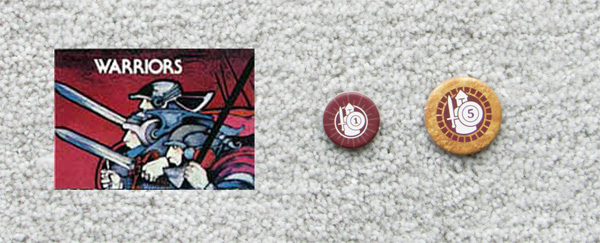 |
- Other Stuff
- Where the original game only had the Heroes, some flags, a dragon miniature, and, of course, the all important keys, the new version has many other components including: Foes (which are fancy minis if you bought the upgrade), miniature skulls, and various other tokens for the many scenarios.
- There are also other items such as player boards and several decks of cards which didn't exist in the original game.
Game Play
- Competitive vs Cooperative
- The major difference between the games is the basic rules for Return to Dark Tower are cooperative where the original game was solely competitive. However, the rules of Return to Dark Tower do have a competitive variant and I'll explain those similarities and differences.
- The competitive version of Return to Dark Tower has some similarities to the original rules. The players must perform 3 tasks and the first to do so wins:
- Complete three hero tests - At the beginning of the game, each hero is dealt 3 Hero Test cards that tell you where to go and what you have to do there. These are very much like having travel around the game board to find the keys in the original game. The main difference is the game tells you were to go so you aren't randomly wandering around the board. At each location, you take the Quest action which is reminiscent of searching the Tomb and Ruins. The player still has to stop at buildings from time to time to gather the required resources.
- Enter the Tower dungeon - The original game has you do a final battle against the Dark Tower by traveling to the Tower's base and commencing your attack. While "enter the Tower dungeon" sounds similar, it is completely different. Instead, you travel to the Tower's base and perform a Quest action. This will simply start the Find-the-Relic search.
- Find the Relic - Once the player enters the Tower dungeon, they use the app to search through a randomly generated layout of rooms to find the relic, loosing resources along the way. The first player to enter the right room, wins the game. The original game, where the first player to win their battle against the Tower wins the game, has nothing like this searching-a-hidden-map mechanic.
- Movement
- In the old game, each player moves one space per turn and must make one complete circuit around the board going clockwise through the 4 kingdoms.
- The new version has increased movement distances (3 spaces instead of 1 and that can be increased) and has no restrictions on direction. Nor is there a need for a given player to visit all kingdoms. This allows more game time to be spent doing the more interesting things (exploring dungeons, battling foes, finding companions) and makes the game feel less repetitive.
- Battling Foes
- In the old game, the Tower managed battles 100%. A battle would go through a number rounds of of attacks and counter attacks where both sides would loose warriors. A player could retreat between rounds if they were being routed, but that was only control they had.
- Battling foes in the new version, while still 100% managed by the app, offers a lot more player interaction. Players choose virtual cards based on the foe's strength and can use typed "advantages" (melee, magic, etc...) to offset the damages of each card. Each Hero has some base Advantages and more can be gained in various ways.
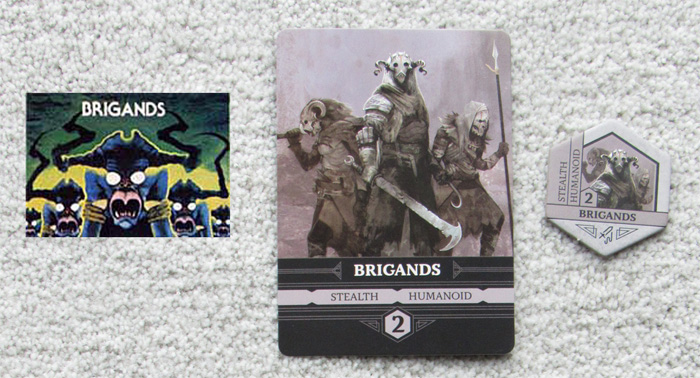 |
- The Dragon
- The Dragon's role has been greatly reduced in Return to Dark Tower. Originally, it was one of the major dangers you'd face when entering a territory and would cause you to immediately lose a quarter of your warriors and gold. But, if you have a DragonSword in your possession when you encountered it, you'd gain all of the warriors and gold the Dragon had previously collected. After you battled it (regardless of if you won or not), you got to move the Dragon to any space on the board, ideally blocking your opponents with it (because they couldn't enter a territory with the Dragon pawn in it). So, it was a powerful mechanic in the original game.
- However, in Return to Dark Tower, the Dragon is simply another foe to deal with as you would any other foe. Albeit a level 4 foe, it's not that badass.
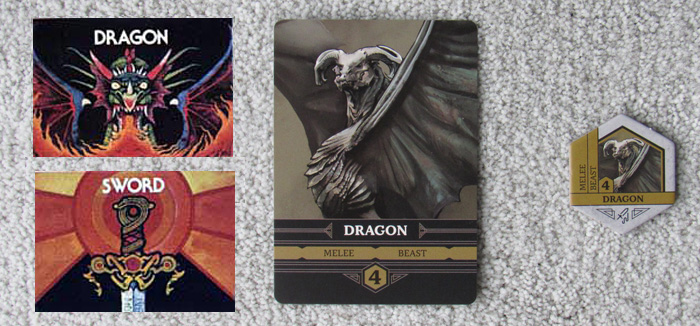 |
- Other Mechanics
- One of the fun parts of the Dark Tower was haggling with the shop owner at the Bazaar. How many times could you press the Haggle button to get a lower price? But, if you haggled too much, you'd anger the shop owner he'd close shop and you'd get nothing! In a clear homage, Return to Dark Tower has the Haggle Die. Instead of reducing prices (since there's no gold in the game), it gives you a chance of scoring some additional items. However, it come with a 33% chance of angering the shop owner and getting nothing! It's a cute Easter Egg, but it doesn't spark the same excitement and is easily forgotten during game play.
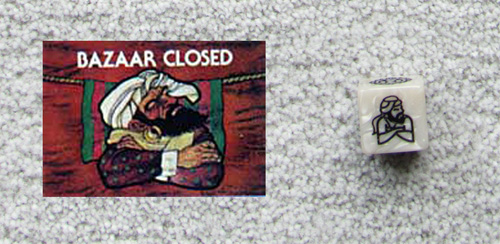 |
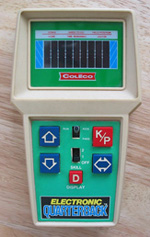
Anyone who was 15-years old in May of 1977 and saw Star Wars for the first time will tell you, "I was blown away! I had never seen anything like it!!!" The original Dark Tower, too, was ground breaking. At the time, electronic games consisted of a mere 4 buttons and a 30-LED screen. The Atari 2600 was still a year away. When the Dark Tower hit the market, it was the pinnacle of toy technology.
That said, the game-play was very much of its day and hasn't aged well. It was ostensibly an Ameri-trash, roll-and-move game where your choices did little to drive the outcome of the game. Yes, there was some strategy involved and you could definitely effect your opponents (via curses and the dragon), but if you found the keys quickly through luck or if you had the DragonSword when you encountered the dragon (and got the subsequent windfall of warriors/gold/food), you had a good chance of winning the game.
Today, where we are surrounded by cutting edge technology all the time, being impressed with new tech has a much higher bar. In terms of modern board games, Return to Dark Tower is technological master piece and I can't think of a single other game that would rival it. However, despite is technological prowess, doesn't standout quite as boldly due to our desensitization to new technology.
Its game play is fun, modern and has a fair amount of re-playability. Objectively, it is a far better game than the original in terms of game play. It has more depth, re-playability, and is less repetitive. Further, and most importantly in my opinion, your choices have more relevance to your journey throughout the game. Fans of the Pandemic franchise will recognize many of the mechanics. The skulls are basically disease cubes and if a city gets its 4th one, it is destroyed. A major strategy of the game, like in Pandemic, is balancing your actions between managing the spread of skulls and working towards goals you need to complete to win the game.
In the end, Dark Tower and Return to Dark Tower are mechanically (ha!) different games with similar themes. I hesitate to even call it a reimplementation. There are many thematic references to the original some of which are obvious like the big, dark tower in the middle of 4 kingdoms, but most feel like Easter Eggs that were thrown in to pay homage to the original's design, but not to replicate it. The Brigands and Dragon for example, as well as the haggle die.
Again, in this poll on BGG half of responders stated nostalgia a reason they backed (or bought) Return to Dark Tower. It is hard to beat nostalgia, to be sure; to this day I still bury the occasional vintage Star Wars toy because I pine for the one that got thrown away long, long time ago. But, is nostalgia reason enough to spend $125 on Return to Dark Tower? No. I'm sorry, it won't give you the same fuzzy feeling you had in the early 80s.
That said, if you want a modern board game with high-quality game play, very cool technology, amazing artwork and happened to have the same flavor of a long lost memory of yours, then Return to Dark Tower would be a worthy addition to your collection. This is especially true if you like coop games.
- An original copy of Dark Tower is obviously hard to find, especially one with a working tower. Note that a lot of "working towers" have been refurbished, but, honestly, that's ok, IMO.
- Your best bet is to search for it on eBay.
|
|
Please support Board Game Helpers by using one of the affiliate links above if you're thinking about purchasing one of these great games. Thank you!
Comments
Login to leave your own comments!
Note: all comments are reviewed by me before they are posted publicly
-
12/09/22 - quik_fix
This was a great blog post, thanks for taking the time to write it!
I was sooo enamored by this game in my childhood. My uncle was an avid Avalon Hill enthusiast and war gamer and gifted me his copy of Dark Tower when I was about 12. I play the holy hell out of that thing all throughout my teenage years. I still have my copy and I've even had it serviced by some dude on eBay to keep it running. The gameplay is silly and dated, but that tower is STILL impressive. It turns heads any time it's on the table and it's still fun to hear that little motor inside, to feel the tension after hitting the "Move" button to see what sort of randomness it is going to spit at you. Or the letdown of hitting the "Move" button and, instead of hearing that whirr, it instead instantly beeped and showed that damn "Lost" picture. Ah, the memories.